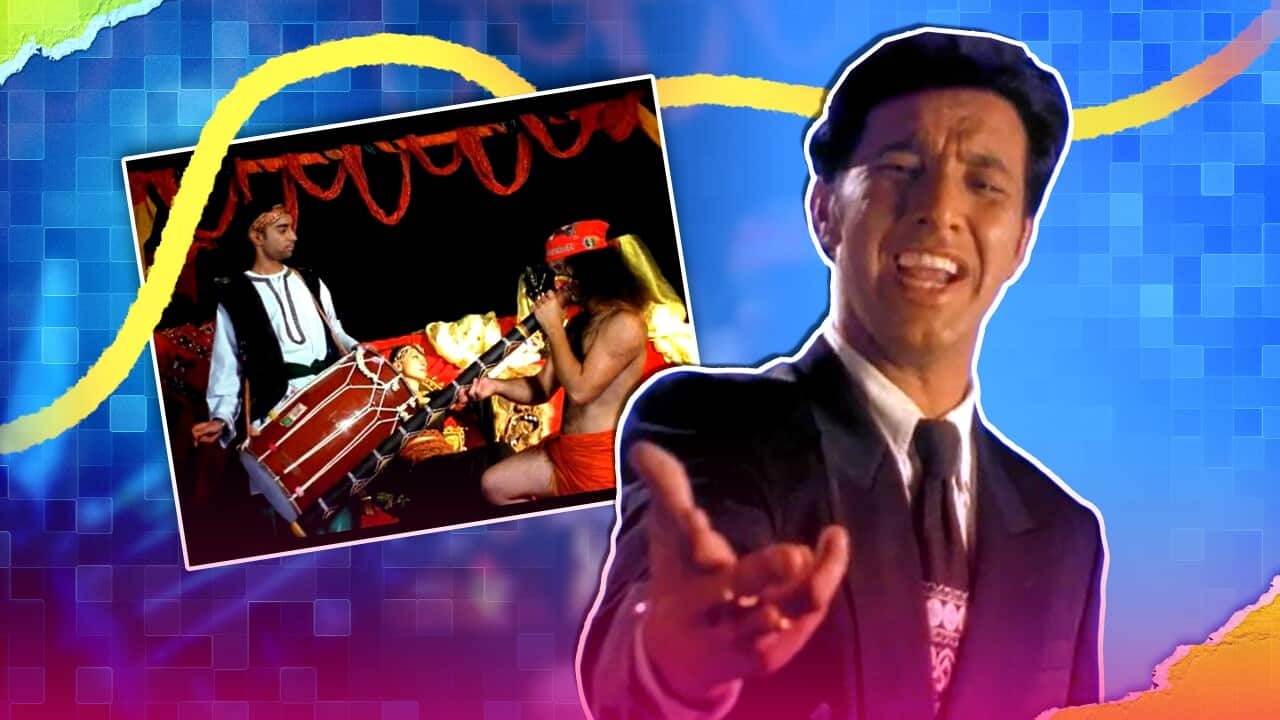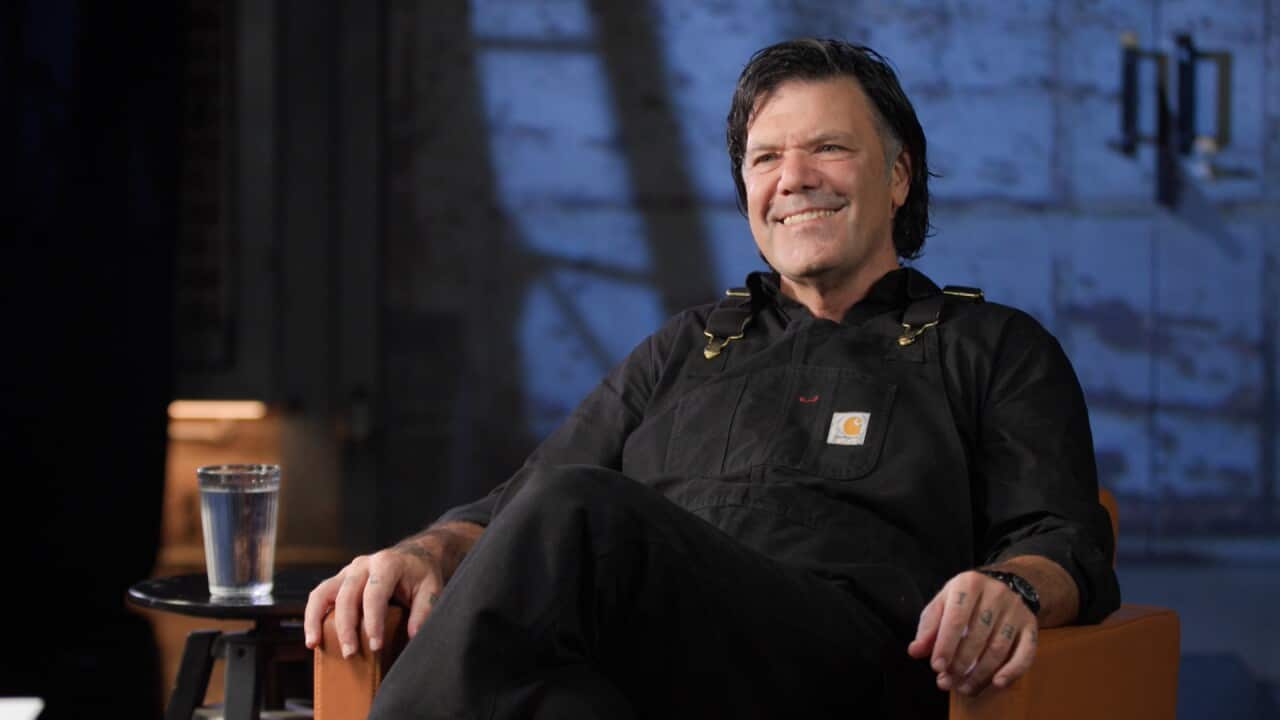Key Points
- Pupinder Mintu’s ‘Didgeridoo Bhangra’ reached number 4 on the MTV Asia Top 10 chart in 1996.
- The music video was directed by filmmaker Anupam Sharma and featured Sydney’s iconic landmarks.
- Blak Douglas, an Indigenous Australian didgeridoo player, says there are similarities between the instrument and Indian percussion.
Filmmaker Anupam Sharma was rummaging through his garage a couple of years back when he made a welcome discovery on an old videotape.
It was one of his earliest directorial projects, a music video for the 1996 single ‘Didgeridoo Bhangra’ by Australian-Punjabi singer Pupinder Mintu.
For Sharma — perhaps best known for directing the romantic comedy ‘UnIndian’ (2015) starring cricketer Brett Lee — the discovery brought back fond memories of multicultural collaboration as a postgraduate student.
“It’s one of my favourite and most emotional projects,” Sharma told SBS Punjabi of the music video, which he uploaded to YouTube in 2021.

A still shows musicians playing the dhol and didgeridoo in the music video for 'Didgeridoo Bhangra'. Credit: Supplied / Pupinder Mintu and Anupam Sharma
Back in 1996, the music video reached number 4 on the MTV Asia Top 10 chart.
How did the dhol meet the didgeridoo?
Almost three decades later, the artist behind 'Didgeridoo Bhangra' remains proud of his pioneering work.
Sydneysider Mintu recalled the song's origins: “One day, I was just sitting with my wife, and she said, 'Punjabi singers based in England have started to add rap to bhangra music; why don’t you add the didgeridoo to a bhangra song?'”
This conversation sparked Mintu to write, compose and voice a song whose Punjabi lyrics introduce the audience to a "new instrument".
The finished product, as visualised by Sharma, garnered attention from the Punjabi community worldwide.
“A lot of people gave me love for it. We had seen many singers from England, but the community was happy to see someone from Australia being recognised,” he said.

Pupinder Mintu in a still from 'Didgeridoo Bhangra'. Credit: Supplied / Pupinder Mintu and Anupam Sharma
Growing up in Perth, our original landowners, the Aboriginal people, loved the didgeridoo, and we used to see them playing the instrument all the time.Pupinder Mintu
The didgeridoo, also known as the yidaki, is a wind instrument that originates from the Yolgnu culture in the north-eastern Arnhem Land region of the Northern Territory.
For Blak Douglas, a Dhungatti man and Archibald Prize-winning artist, the instrument has been a lifelong pursuit.
The classically trained yidaki player shared the correlation between the didgeridoo and Indian percussion instruments like the tabla (hand drums).
The language that you learn to play the yidaki is directly connected to how a tabla drum is played – it is a phonetic language that is pronounced with the tongue, and master tabla players speak the same language.Blak Douglas
The didgeridoo on ‘Didgeridoo Bhangra’ was played by a young individual from north-western Perth.
“We found one guy, a young fellow, and he played freelance didgeridoo for three hours and we included parts that matched the pitch of the song in the final cut,” Mintu recalled.
Sharma said: “For Mintu to use the inherent beat of the didgeridoo and mix it with the bhangra beats was pure genius.”
He said this innovative blend set Mintu apart from his peers in the mid-'90s.
“There were not many Punjabi singers in the late ‘90s, and Mintu was the first Punjabi singer from Australia,” he added.
Bridging cultures through music
Sharma said the music video was filmed in four days with the aim of spotlighting Australia's landmarks and diversity.
Using diverse elements and multiculturalism was in our DNA and (we felt) it shouldn’t be a tick (box) item, it should be natural.Anupam Sharma
Such cross-cultural collaborations “play a very important role in an inclusive society,” he added.
Like Mintu, who said he felt more connected with his Punjabi roots through music, Douglas found connection to his Aboriginal ancestry through the didgeridoo.
“I was searching for my identity like many of our youth, and I was desperate to have an affiliation to my Aboriginal ancestry. I wanted to be the guy playing the 'didge' (didgeridoo),” he shared.

Still from 'Didgeridoo Bhangra'. Credit: Pupinder Mintu and Anupam Sharma
“For me personally, seeing First Nations and Indian creators come together demonstrates what I’ve always known: when we focus on the things that connect us, whilst learning about and respecting our differences, we create ties of solidarity and strength that underpin a connected community,” Singh said in a statement provided to SBS Punjabi.
Sharma shared similar sentiments.
“What happens when you go out on the street, you hear different accents, different music, see different colours and we have to have that in the audio and screen world. This is important for people not to feel marginalised,” he said.
For news, information and interviews in Punjabi from across Australia and homeland, you can tune in to SBS Punjabi live from Monday to Friday at 4 pm on on digital radio, on channel 305 on your television, via the or stream from our . Also, follow us on and .





